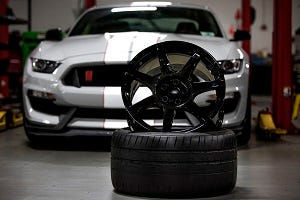The Ford Shelby GT350R muscle car has shed 60 lb. in weight through adoption of carbon-fiber-composite wheels. Ceramic plasma arc sprayed onto the front wheels provides thermal protection from brake heat.Carbon-fiber parts are notoriously challenging when it comes to delivering a flawlessly smooth painted surface—the kind of finish Ford demands for all of its vehicles. Several proprietary new processes were developed that resulted in a robust, high-gloss black finish that not only looks good, but ensures a long life for the wheels.
July 13, 2015
The Ford Shelby GT350R muscle car has shed 60 lb. in weight through adoption of carbon-fiber-composite wheels. Ceramic plasma arc sprayed onto the front wheels provides thermal protection from brake heat.
Carbon-fiber parts are notoriously challenging when it comes to delivering a flawlessly smooth painted surface—the kind of finish Ford demands for all of its vehicles. Several proprietary new processes were developed that resulted in a robust, high-gloss black finish that not only looks good, but ensures a long life for the wheels.
|
Carbon fiber composite wheels boost Ford muscle car's performance. |
Manufacturing carbon-fiber wheels begins with the creation of the preformed internal carbon structure, composed of precisely manufactured carbon strands arrayed into woven fabrics. The elements are then placed into a mold using state of the art manufacturing techniques.
An RFID chip with a unique tracking number is embedded in this structure, and each wheel is individually entered into a quality assurance system. Once this structure is assembled, it's infused with resin and cured at high temperatures. This process results in a one-piece wheel that ensures maximum strength, eliminating the need to bond or glue the wheel's spokes and barrel components together.
As the wheel cures, 61 individual checks and more than 246,000 data points are logged before it's released from the machine. To guarantee quality parts, the cured wheels are analyzed using a 3D computerized tomography (CT) imaging process in which more than 18,000 X-ray images are taken. If the wheel passes inspection, it undergoes machining for the valve stem and mounting hardware holes before it gets painted, coated, assembled, dimensionally checked and shipped to Ford's Flat Rock Assembly Plant for installation on a new Shelby GT350R Mustang.
When brake temperature measurements were taken, the Shelby GT350R's were found to be creating rotor temperatures in excess of 900 degrees Celsius, thereby necessitating thermal protection. For decades aerospace companies have treated turbine blade materials subject to extreme heat with ceramic coatings to help improve durability. The technology is also used in top-tier open-wheel racing environments. A thermal barrier coating system developed by Carbon Revolution uses this same technology.
Created specifically for motorsport and aerospace applications where extreme temperature conditions are encountered, Carbon Revolution's thermal barrier coating system uses a multistage, multimaterial coating formulation that provides an excellent thermal barrier. Using a plasma arc gun to liquefy a ceramic material, the wheels are coated at critical points around the inner wheel "barrel" and on the back of the spokes. The result is an incredibly thin, nearly diamond-hard coating that reliably shields the resin from heat - reducing maximum wheel temperatures and allowing continuous track use by even the most aggressive drivers.
Carbon Revolution also had to address the harsh conditions typical of roads, including the UV environment, corrosive salts and road chemicals. It became apparent that to achieve the durability required by Ford, a special coating would need to be developed to protect the composite from the environment.
That the new Ford Shelby GT350R Mustang is fast should come as no surprise, but by cutting the weight of each wheel nearly in half compared to an equivalent aluminum wheel (18 pounds versus 33 pounds), handling and acceleration performance see serious benefits. The wheels also provide a reduction in rotational inertia of more than 40 percent, which positively impacts acceleration and braking performance. The wheels are so light that the springs and dampers had to be recalibrated because the suspension can respond considerably faster to road inputs.
"The GT350R wheels and tires were developed to be the most track-capable parts we've ever produced," said Adam Wirth, chassis supervisor, Ford Performance. "The carbon fiber wheels reduce vehicle weight by 60 pounds compared to aluminum, yet are stiffer for better steering response.
Lowering overall curb weight in general is beneficial to a car's dynamics, but a reduction in unsprung weight (those components not supported by the suspension) can have a significant impact on handling and performance. Less unsprung weight helps vehicles start, stop and turn faster by reducing wheel rotational inertia, dramatically improving response time to driver input. Lower unsprung weight also translates to suspension components not having to work so hard to keep the tires in contact with the road over undulating or broken surfaces.
You May Also Like



